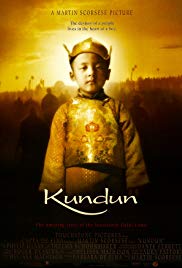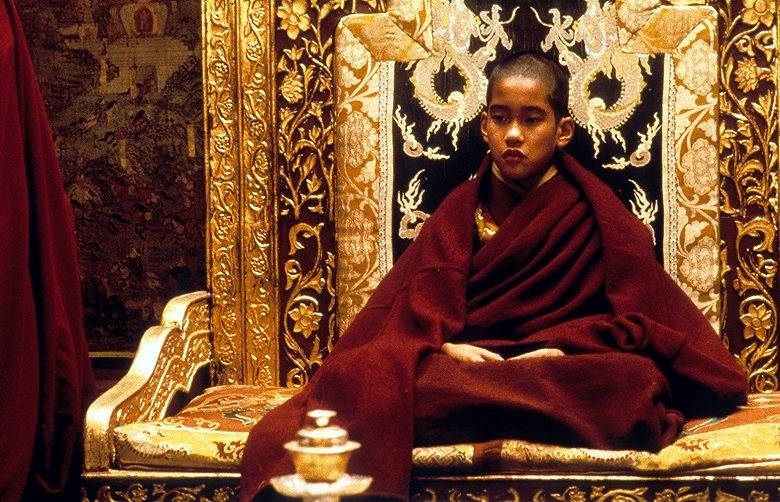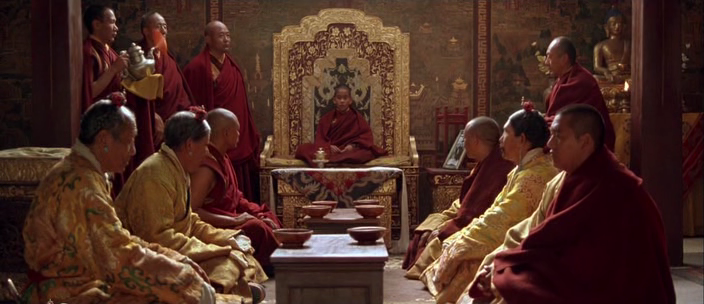KUNDUN
SUBJECTS — World/Tibet & China; Religions/Buddhism;
SOCIAL-EMOTIONAL LEARNING — Rebellion; Leadership;
MORAL-ETHICAL EMPHASIS — Trustworthiness.
AGE: 13+; MPAA Rating — PG-13 (for violent images);
Drama; 1997; 128 minutes; Color.
There is NO AI content on this website. All content on TeachWithMovies.org has been written by human beings.

SUBJECTS — World/Tibet & China; Religions/Buddhism;
SOCIAL-EMOTIONAL LEARNING — Rebellion; Leadership;
MORAL-ETHICAL EMPHASIS — Trustworthiness.
AGE: 13+; MPAA Rating — PG-13 (for violent images);
Drama; 1997; 128 minutes; Color.
TWM offers the following worksheets to keep students’ minds on the movie and direct them to the lessons that can be learned from the film.
Film Study Worksheet for a Work of Historical Fiction and
Worksheet for Cinematic and Theatrical Elements and Their Effects.
Teachers can modify the movie worksheets to fit the needs of each class. See also TWM’s Historical Fiction in Film Cross-Curricular Homework Project.

This is the story of the 14th Dalai Lama, from the “discovery” of his “reincarnation” at age two until his self-exile in India after the Chinese occupation of Tibet. Before he reaches maturity, the Dalai Lama is placed at the head of his small, undeveloped and very religious country. He must contend with the surging strength and territorial ambitions of China, a newly unified and invigorated great power. The film shows how the boy grows to be a young man, trying to do what is right and serve his people, while resisting the Chinese through nonviolence. The film also shows some of the superstitions and practices of Tibetan Buddhism.
Selected Awards: 1998 National Society of Film Critics Awards: Best Cinematography; 1998 Academy Awards Nominations: Best Art Direction-Set Decoration; Best Cinematography; Best Costume Design; Best Music – Original Dramatic Score; 1998 Golden Globe Awards Nominations: Best Musical Score.
Featured Actors: Tenzin Thuthob Tsarong, Gyurme Tethong, Tulku Jamyang Kunga Tenzin, Tenzin Yeshi Paichang, Tencho Gyalpo.
Director: Martin Scorsese.
“Kundun” will introduce children to Tibet, to its relationship with China, and to the Dalai Lama.
MODERATE. The script of this film was written by people who revere the Dalai Lama. It was reviewed and authorized by the Dalai Lama himself. The movie should be seen in that light.
China continues its efforts to undermine the Tibetan culture. The Dalai Lama is still in exile and has become a major religious leader. Make sure your child understands this and then ask and help your child to answer the Quick Discussion Questions.

For a brief description of Buddhist theology see Learning Guide to Little Buddha.
Tibet is a huge country, about the size of Western Europe or three times the size of California. It consists of a high plateau surrounded by some of the highest mountain ranges in the world. Tibet is rich in mineral resources. The climate is dry with temperatures ranging from very cold in the mountains to mild in the valleys. The dry climate discourages epidemics and permits the storage of grain for 50 to 60 years. The Tibetan people, between 2,000,000 and 3,000,000 in number, come from one ethnic group. They share the same language, customs, and religion. Before the 1950 Chinese invasion, Tibet was ruled by a theocracy and sought isolation from the world. Its economic development was minimal. The vast majority of its people were nomads or subsistence farmers.
The most recent Chinese invasion of Tibet occurred in 1950. China has attempted to pull Tibet into the modern world, bringing modern medical care, modern economic development, a network of roads and bridges, modern education and modern Chinese political indoctrination (formerly Communist but we don’t really know what to call it now). The Chinese are also attempting to destroy the religious culture of the Tibetans and undermine the power of the religious hierarchy. Tibet is flooded with many temporary Chinese immigrants. The Tibetans resent Chinese influence. There was an open rebellion in 1959, followed by severe Chinese repression, including forced collectivization of farms. There are occasional magazine and newspaper articles about the plight of the Tibetan people. See, e.g., Los Angeles Times, Tuesday August 3, 1999, Page 1.
After years of trying to work within the restraints imposed by the Chinese government, the Dalai Lama fled Tibet in 1959. He established a Government in Exile at Dharamsala, India, and he has fought the Chinese occupation of Tibet through nonviolent means. In 1998 he was awarded the Nobel Prize for Peace. The citation reads:
The Committee wants to emphasize the fact that the Dalai Lama in his struggle for the liberation of Tibet consistently has opposed the use of violence. He has instead advocated peaceful solutions based upon tolerance and mutual respect in order to preserve the historical and cultural heritage of his people.
The Dalai Lama has developed his philosophy of peace from a great reverence for all things living and upon the concept of universal responsibility embracing all mankind as well as nature.
The Dalai Lama continues his nonviolent resistance to Chinese rule. The situation continues to evolve. In early 2000, the young Karmapa Lama, who the Chinese had been grooming as a counterweight to the Dalai Lama’s authority, fled from Tibet. He has now joined the Dalai Lama in exile in India.
During his exile, the Dalai Lama has grown from the leader of a small and superstitious sect of Buddhism to a broad-minded and recognized leader of one of the major religions of the world. He has stated that his reincarnation will not occur in Tibet as long as it is controlled by China.
1. See Discussion Questions for Use With any Film that is a Work of Fiction.
2. If the Dalai Lama returns to Tibet and the Chinese withdraw their troops, what should happen in Tibet in relation to the power of the monks and the Dalai Lama, democracy, and economic development?
3. If the Chinese invasion was wrong, should the United States have helped the Dalai Lama and his supporters in Tibet? What form should this help have taken? Help from CIA agents? Troops? Nuclear missiles? Or should the U.S. have simply let China take control of this large and valuable country? What are the pros and cons of each course of action and what would you have done?
4. Who is Mao Zedong and what was his relationship with China and with Tibet?
5. Do you think that this film uncritically accepts reincarnation, the superstitious practices of Tibetan Buddhism, and the legitimacy of a theocracy in Tibet? Does this affect your view of the film?
6. In what way is this film propaganda? If it is propaganda, how does that affect the way in which you react to the film? Compare this film to some of the excellent Allied World War II propaganda, such as Mrs. Miniver. How do these films get their point across? Do they honestly foster a frank discussion of the issues of the time?
1. Do you believe that nonviolent civil disobedience is an effective strategy in all situations? Is it working now for the people of Tibet? Would it have worked against Hitler, Stalin or Pol Pot?
Suggested Response:
This question can be extended by asking children to compare the following situations: the Indians seeking independence from the British Empire, see Gandhi; the Irish seeking independence from Britain, see Michael Collins; blacks in the American South seeking relief from segregation, see The Long Walk Home or the Burmese people in their resistance to military rule, see Beyond Rangoon. Other examples are the Russian people seeking the end to the Soviet Union (when Yeltsin faced down Soviet tanks); and the people of the Philippines going into the streets to oust Ferdinand Marcos.
2. Compare and contrast Kundun and Mahatma Gandhi describing the situations they faced, their response to the situations, how their response to the situations changed over time, and the political/religious theory they applied. See Learning Guide to “Gandhi“.
3. Compare and contrast Kundun and Dr. Martin Luther King describing the situations they faced, their response to the situations, how their response to the situations changed over time, and the political/religious theory they applied.
4. Compare and contrast Kundun and Michael Collins describing the situations they faced, their response to the situations, how their response to the situations changed over time, and the political/religious theory they applied. See Learning Guide to “Michael Collins“.
5. Why do you think Kundun’s pleas to the West for help went unanswered?
Discussion Questions Relating to Ethical Issues will facilitate the use of this film to teach ethical principles and critical viewing. Additional questions are set out below.
(Be honest; Don’t deceive, cheat or steal; Be reliable — do what you say you’ll do; Have the courage to do the right thing; Build a good reputation; Be loyal — stand by your family, friends, and country)
1. Describe how the life of the Dalai Lama has honored this Pillar of character.
Assignments, Projects, and Activities for Use With Any Film that is a Work of Fiction.
1. Class debates can be staged or papers can be written on any of the topics in the Discussion Questions section.
2. Have students locate on a map, China, Beijing, Tibet, Himalayan Mountains, India, Lhasa, and Dharamsala.
3. The story of Kundun and Tibet is an ongoing drama. Have students search the internet or back issues of newspapers to find the latest developments.
Because of the Dalai Lama’s great public relations skills there are usually current articles in newspapers and magazines concerning this issue.
In addition to websites which may be linked in the Guide and selected film reviews listed on the Movie Review Query Engine, the following resources were consulted in the preparation of this Learning Guide:
This Learning Guide was last updated on December 10, 2009.